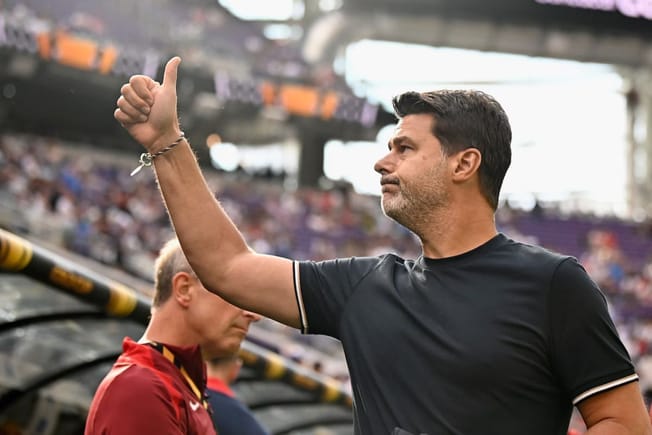Quick Hits
- The United States men’s national team nearly pulled off a big-time upset against England on Friday, but couldn’t quite get over the line
- Here are the key factors that helped lead the U.S. to an impressive performance against the European giant
Before the United States kicked off against England, they received some news: Iran had pulled off a last-minute win against Wales. With that result, the U.S. knew the only outcome against England that would meaningfully aid their quest to progress in the World Cup was an unlikely win. Anything other than a win and the U.S. would still have to beat Iran in the final game of the group stage to make it to the knockout rounds.
As we now know, the United States didn’t beat England. They drew 0-0.
Despite the very real impulse to look past England to the more critical matchup against Iran, the United States – showing some serious character – almost pulled off an unthinkable upset.
Here are the key factors that helped lead the U.S. to a near victory versus England.
DEFENDING IN THE 4-4-2
The key tactical shift from the Wales match to the England match was Gregg Berhalter’s decision to defend in a 4-4-2 formation.
While the United States defended, Tim Weah shifted into the middle to form a defensive forward line with striker Haji Wright while midfielder Weston McKennie flared out right to create a flat-four midfield line with Christian Pulisic, Yunus Musah, and Tyler Adams. As soon as the opening whistle blew, it became clear that the purpose of this setup was to push the ball out wide and to stop England from building through the middle.
This prevented midfielders Declan Rice and Jude Bellingham from having the same influence on the game that had on Monday against Iran.
One of the things that defending in a 4-4-2 did for the #USMNT was limit the contributions that Declan Rice and Jude Bellingham made on the ball. pic.twitter.com/aZZKQX8bwQ
— Justin Egan (@EganSoccerWords) November 25, 2022
Wright and Weah worked in unison and were positioned very centrally to keep the ball out of the middle. While the ball-side forward positioned himself to prevent middle penetration, the weak-side forward would shadow Rice, who was usually England’s deepest midfielder. When England attempted to reverse the ball and switch the point of attack, Wright and Weah expeditiously switched roles.
Both these factors made it very difficult for England’s backline to find any penetrating passes into central midfield and resulted in the U.S.’s opponents playing in the wide areas.
How did this not go in?! 😳
— FOX Soccer (@FOXSoccer) November 25, 2022
England nearly gets the first goal of the game pic.twitter.com/YcHNUGAwYh
While the 4-4-2 was successful in forcing England to the sideline, there were a few causes of concern in the U.S. defensive setup.
England’s most dangerous attacking chances came when they sent runners into the halfspaces when American fullbacks extended too forward. This forced the center backs out wide to defend dangerous attacking players one-v-one in the optimal assist zone. Things got a little dicey for the last 15 minutes of the first half, but the U.S. reverted to its standard 4-3-3 before Berhalter made a few tactical tweaks at halftime to solidify the defensive line.
In the second half, the U.S. returned to 4-4-2 but noticeably tightened up the gaps between the fullbacks and center backs to close down the holes in the halfspaces.
IMPROVEMENTS TO THE COUNTER ATTACK
As we predicted earlier this week, one of the keys for the United States against England was the ability to attack in transition. While the United States didn’t score in transition on Friday, there were visible improvements in how they executed their counter attacks compared to the blunders they made against Wales on Monday.
It was apparent from the jump that the Americans’ primary attacking strategy was going to be the counter attack, given their more reserved defensive setup. And the U.S. owned that fact. Instead of playing cute, possession-based soccer, they looked comfortable playing vertically almost every time after regaining possession.
Defending in a 4-4-2 sped up the United States’ transition play, too. Since Weah, arguably the best American option on the counter, played up top in Berhalter’s 4-4-2 scheme, he could quickly move into space because he was already further up the field.
Finally, the emphasis on transition attacking seemed to bring the best out of Pulisic. In case you were wondering, the best version of Pulisic is the one where he picks out a defender and runs right at them on the dribble. The USMNT’s game against England featured a lot of opportunities for Pulisic to dribble at an isolated defender because of commitment to direct play instead of possession-based soccer.
That's right, there's just one England player in this list#FIFAWorldCup #ENGUSA pic.twitter.com/MGQTAovP6Z
— Opta Analyst (@OptaAnalyst) November 25, 2022
THE MMA MIDFIELD DICTATED THE GAME
Berhalter went back to the McKennie-Musah-Adams midfield well against England – and it paid dividends.
Musah and McKennie were the midfield engines that drove the U.S.’s attack. They regularly ran past England players in midfield, forcing the United States’ opponents to drag them down in the open field. It was especially fun to watch how well McKennie combined on the right side with fellow young guns Weah and Sergiño Dest.
TYLER. ADAMS.
— FOX Soccer (@FOXSoccer) November 25, 2022
What a tackle for the @USMNT 😤🇺🇸 pic.twitter.com/xKC180b5xK
Now, to give Tyler Adams some love. Adams looked like he was single handedly covering the entire field defensively. While the shift to the 4-4-2 helped the U.S. congest and shut down the middle, it was Adams who was largely responsible for snuffing out every serious transition opportunity for England. He played an excellent game on Friday.
QUESTIONS REMAIN FOR THE MATCHUP WITH IRAN
The task ahead is a simple one for the United States: beat Iran and they’re in the Round of 16. Despite the strong showing against England, there are still some questions facing the U.S. before Tuesday’s critical match.
Who the U.S. should play at striker is still an open question.
Wright did nothing to definitively prevent Berhalter from considering a return to Josh Sargent or giving Jesus Ferreira his shot up top. And while Berhalter deserves credit for the successful gameplan that the U.S. executed against England, there were some issues with his game management. Despite knowing how critical the United States’ matchup against Iran was going to be before the match against England kicked off, Berhalter made the decision to start Tim Ream, McKennie, and Dest, even though those players were one yellow card away from a one-game suspension.
Additionally, Berhalter did not make his first substitution until the 77th minute, which is notable given that the U.S. is about to play a third game in eight days on Tuesday.
With Iran only needing a draw to move to the next round, though, the biggest question facing the U.S. is this: how are they going to break down their opponents? Berhalter will have to take out his tactics board to figure out a way for the U.S. to play more dynamically against the bunker-and-counter strategy than they did against Wales. Whatever the answers to those questions, the team must build on the success they found against England to secure a crucial three points against Iran.







Comments